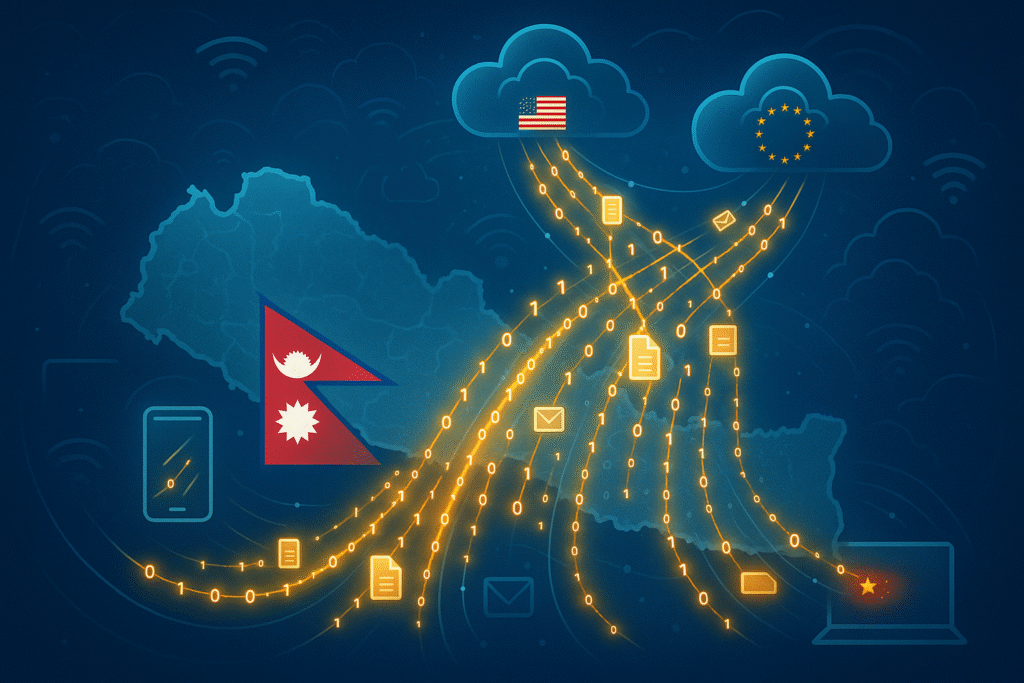
In the last decade, Nepal has experienced a digital revolution. From QR payments in teashops to virtual classes in remote hills, technology is reshaping everyday life. But with this transformation comes an invisible cost. While we celebrate access and innovation, we often overlook a silent threat: data flight.
Just like capital flight drains money from the economy, data flight quietly extracts value from our digital lives. It is the process by which our personal and institutional data is sent to servers and systems in foreign countries, often without our knowledge or consent. While this may seem harmless, the implications for privacy, national security, and digital sovereignty are profound.
Data flight refers to the passive or unnoticed transfer of digital information such as photos, messages, financial records, browsing history, health data, and more from a user or organization in one country to servers located abroad. This can happen through cloud backups like Google Drive and iCloud, foreign apps like Facebook, TikTok, and Instagram, embedded website trackers such as Google Analytics and Facebook Pixel, smart devices like Alexa, Google Home, and Smart TVs, and online services including telehealth, edtech, and fintech apps.
When a student in Pokhara backs up class notes to Google Docs, or a family in Kathmandu uses Alexa to check the weather, that data might be stored in Singapore, Germany, or the United States. This information is governed by foreign data laws, not Nepal’s.
How It Happens in Nepal: Everyday Examples
- Cloud Sync
Nepali users commonly sync their phones and laptops to foreign cloud services, sending gigabytes of data abroad daily. Every photo backed up, every chat saved, every document uploaded might be hosted in a foreign jurisdiction. - Fintech and Mobile Wallets
Digital wallets like eSewa, Khalti, and IME Pay use foreign cloud services and analytics tools. Even if the app is Nepali, the backend could be in India, Singapore, or the U.S. User behavior, transaction logs, and usage trends are valuable data points. - News and Entertainment Websites
Popular sites such as ekantipur.com, Setopati, or Ratopati often embed trackers from Google or Meta. These trackers collect user interaction data and send it to foreign advertising networks. - Education and Health Apps
Students using global MOOCs (like Coursera or edX) and patients monitoring their health with foreign apps may unknowingly allow their academic progress or medical history to be processed and stored abroad. - IoT Devices and Smart Tech
Smart TVs, fitness bands, and voice assistants collect vast amounts of behavioral data. Even if purchased locally, these devices often “call home” to servers in North America, Europe, or China.
Why Should We Be Concerned?
- Privacy Risks
- Data stored outside Nepal is governed by foreign laws. It may be accessed, analyzed, or sold without meaningful consent. If leaked or hacked, the consequences can be personal, social, or political.
- Legal Insecurity
- Nepal’s legal system has limited reach over foreign tech companies. If your data is misused or exposed, you might have no realistic way to seek justice.
- Economic Loss
- Data has economic value. When foreign firms extract, process, and monetize data from Nepali users, they build smarter systems, more profitable ads, and stronger businesses—while Nepal remains a passive data provider.
- National Security
- Government communications, infrastructure plans, or public health data could be exposed to surveillance. Foreign intelligence agencies might legally access data stored under their own jurisdiction.Digital Dependency
- Heavy reliance on global tech platforms discourages local innovation and weakens our capacity to build sovereign systems
More Examples of Data Flight’s Impact
A local NGO collects citizen feedback through a free online form tool. That data, including personal stories and contact information, is stored in an American server.
A tech startup uses free cloud storage from a global provider. One day, due to geopolitical tension, access is restricted. The company loses data and trust.
A student uploads a controversial opinion essay on a foreign-hosted site. Later, it’s used by a foreign platform to train AI language models, completely without consent.
What Can We Do? Solutions for Users and Policymakers
Educate and Build Awareness
Public campaigns, school curricula, and media literacy efforts must include digital privacy and sovereignty topics. Organizations like the Nepal Institute of Cyber Literacy and Security (NICLS) are stepping in to raise awareness, advocate for digital rights, and promote national strategies around cyber policy. Initiatives like these are vital to preparing the next generation of Nepali citizens to navigate and protect their digital lives.
Encourage Local Alternatives
Support Nepali-developed software, storage solutions, and communication tools. While not perfect yet, local platforms can evolve with the right backing.
Use Privacy-Conscious Tools
Switch to privacy-focused browsers, email, and search engines. Avoid unnecessary app permissions.
Push for Institutional Change
Government bodies, banks, hospitals, and universities should adopt data storage policies that prioritize localization and encryption.
Enact Strong Data Protection Laws
Nepal urgently needs comprehensive data protection legislation that defines rights, responsibilities, and boundaries for data usage.Form Public-Private Alliances
Tech companies, civil society, and academic institutions must collaborate to build national frameworks and digital infrastructure.
Reclaiming Our Digital Sovereignty
Nepal’s digital transformation is a source of pride. But to make it sustainable and safe, we must pair access with accountability. Every byte of data matters. When we give it away freely, we give away leverage, identity, and autonomy.
The internet does not recognize political boundaries, but nations must. As data becomes the new currency of power, Nepal must move from passive consumer to active steward of its digital future.
“In the sky of the internet, your data is always flying. Make sure it flies where you want it to.”
Let us not just use the internet. Let us shape it. Let us own our data, our tools, and our tomorrow.
If this article resonates with you, share it widely. It starts with awareness, but it ends with action.